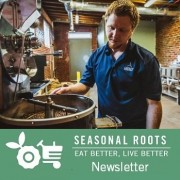The right kale recipes made me, a grown woman, love kale, too!
– Written by Meredith M, veggie fairy & neighborhood Market Manager in Northern Virginia
– Photo by Sherri B, veggie fairy & Area Manager in Richmond, whose son can’t wait to sink his teeth into some fresh, local kale
I’ve never been much of a “routine” person, despite my best efforts. However, every Wednesday after I complete all my deliveries I do the exact. Same. Thing.
Upon returning home, I unload all the boxes my members have given me to reuse and recycle (thank you!) Next, I head to my kitchen, where I unload and put away my own basket of goodies — everything but the kale and an apple (or a handful of grapes in the summertime). Then I proceed to make my favorite lunh…
Have you always read about the numerous health benefits of kale, but just didn’t have that easy, go-to recipe that you would want to regularly use? Well, I’ve got that recipe.
Start by tearing up a TON of kale from one of our local farmers. Don’t be timid. This recipe is so good you’ll want more.
Top your heaping plate of kale with a sliced Saunders Brothers apple of your favorite variety. I’m partial to the sweet tartness of the Piney Golds at the moment.
Next, toss on some pecans, craisins, and blue cheese, feta, or goat cheese — whatever your preference.
Lastly, drizzle some delicious homemade vinaigrette. You can whip up a vinaigrette using extra virgin olive oil, local honey from Alfredo’s Beehive, salt, pepper, and some of that apple cider vinegar you’ve been choking down through tears ever since you read about that miracle potion. Go ahead and make a big batch of this vinaigrette. It lasts a long time in those mason jars you hang on to “just in case,” and it’s fabulous on a basic spinach, cucumber, and strawberry salad. So good! Here’s the step-by-step:
VINAIGRETTE
1/2 c extra virgin olive oil
1/2 c ALFREDO’S BEEHIVE honey
1/4 to 1/3 c apple cider vinegar
salt & pepper, to taste
(Kale salad recipe thanks to Homemadefoodjunkie.com.)
Ever since I began making this salad, I’ve been craving it. And I bet you will too. This one even made the cut for my Thanksgiving menu, and the competition was stiff — a heated battle between the kale and all the usual hearty stuff… but the kale won. It’s not easy being in the line-up alongside mouthwatering mashed potatoes, cherry pie, and the best corn casserole you’ve ever tasted, yet this salad still holds its own. But I digress.
Looking for a saltier alternative? That brings us to the next step in my Wednesday routine. I heat up the oven and use the rest of that curly bunch of greens to make chips!!
The spicy kale chip recipe I discovered long ago has never failed me. I tweak it here and there, but it comes out great every time. Even my harder-to-please family will chow down on these! I also recommend making kale chips when you need to use up the rest of your kale the day before Delivery Day to make room for the new bunch you’re about to receive. These zingy, savory chips disappear fast.
KALE CHIPS
(adapted from Ohsheglows.com)
1/2 bunch local kale leaves (approximately)
1 T extra virgin olive oil
1-1/2 t garlic powder
1/2 t chili powder
1/2 t onion powder
1/2 t smoked paprika
1/4 t fine grain sea salt or pink Himalayan sea salt
1/8 t cayenne pepper (optional)
Directions:
1. Preheat oven to 300. Line a large rimmed baking sheet with parchment paper or a silicone mat.
2. Remove leaves from the stems of the kale and roughly tear into large pieces.
3. Place kale in large bowl and massage in the oil until all the nooks and crannies are coated well. Combine all seasonings in separate bowl, then sprinkle on kale and toss to combine.
4. Spread kale onto the baking sheet in a single layer, being sure not to overcrowd the kale.
5. Bake for 10 minutes, rotate the pan, and bake for another 12-15 minutes until the kale begins to firm up. The kale will look shrunken, but this is normal. I bake for 25 mins total in my oven.
6. Cool the kale on the sheet for 3 minutes before digging in! Enjoy immediately, since they lose their crispiness with time.
There are lots more easy recipes to help you get in the kale habit on the Seasonal Roots Pinterest kale board.
And if you want to learn pretty much everything there is to know about kale, check out the Happy Happy Vegan blog for a deep dive!
ABOUT SEASONAL ROOTS
Since 2011, Seasonal Roots’ online farmers market has connected Virginia families with local family farmers who use sustainable, humane practices. Our veggie fairies – mostly moms who believe in living better through scrumptious, healthy eating, being kind to animals, protecting the environment, and spreading joy – home-deliver freshly harvested produce, pastured eggs, grassfed dairy and meat, plus artisan fare. We empower our members to eat better and live better with more nutritious, flavorful food that’s good for us and good for the planet. More info at seasonalroots.com.




























